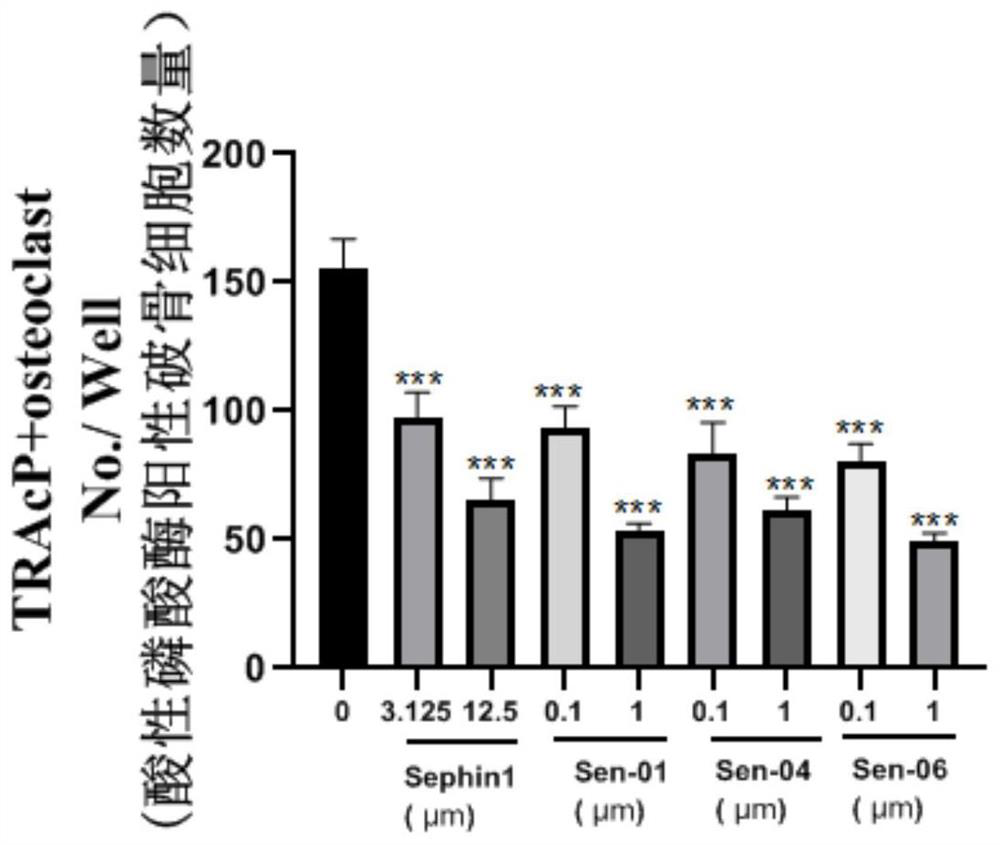Substituted guanidyl-containing derivative and application thereof in preparation of osteoclast differentiation inhibitor
An osteoclast, differentiation inhibition technology, applied in bone diseases, organic chemistry, drug combination, etc., can solve problems such as high price, need for subcutaneous injection, and limited use
- Summary
- Abstract
- Description
- Claims
- Application Information
AI Technical Summary
Problems solved by technology
Method used
Image
Examples
experiment example 1
[0042] Experimental example 1 Substituted guanidine derivatives Sephin1, Sen-01, Sen-04, Sen-06 inhibit RANKL-induced osteoclastogenesis or bone resorption in mice
[0043] Take the femur and tibia of C57BL / 6 mice, strip the muscle and cut off both ends, use a syringe to absorb α-MEM to repeatedly wash the bone marrow cavity of the femur and tibia, and flush out the bone marrow until the bone marrow cavity turns white, at 37°C, 5% CO 2 Adherent cells were taken after being placed in the incubator for 48 hours, and the cells were inoculated in 96-well plates. After that, different concentrations of drugs were added to the drug group, and the stimulator RANKL was added 2 hours later (the final concentration of RANKL was 50 ng / ml). 3-4 days after induction, carry out TRAP staining, observe and take pictures under a microscope, and count osteoclasts as TRAP-positive cells with more than 3 nuclei. The bone resorption plate was washed to remove cells on the 7th day of induction, obs...
experiment example 2
[0045] Experimental Example 2 Substituted Guanidyl Derivative Sephin1 Improves Bone Density in Ovariectomized (OVX) Mice Osteoporosis Model in Vivo
[0046] Fifteen C57BL / 6 female mice aged 8 weeks, negative control group (sham) were 5 mice in sham operation group, and the remaining 10 OVX model mice were randomly divided into positive control group (ovx), drug group Sephin1 group (ovx +Sephin1 (4mg / kg)), 5 rats in each group. The negative control group and the positive control group were injected with normal saline; in the drug intervention group, 4 mg / kg of Sephin1 was injected intraperitoneally, and the drug was injected intraperitoneally the next day. All mice were continuously injected intraperitoneally for 6 weeks. Reserved in formalin.
[0047] Through Micro-CT scanning, it was found that compared with the negative control group, the bone mass of the mice in the OVX model group was significantly reduced, while the Sephin1 intervention group significantly increased the ...
experiment example 3
[0049] Experimental example 3 Substituted guanidine derivative Sephin1 inhibits osteoclast differentiation and bone activity in patients with osteoporosis
[0050] Lymphocytes were isolated from the peripheral blood of patients with osteoporosis, and CD14 magnetic beads were used to sort the lymphocytes, and the obtained cells were inoculated on artificial bone sheets coated with The Osteo Assay was cultured in 96-well plates, and drugs of different concentrations were added to the drug group, and the stimulator RANKL was added after 2 hours (the final concentration of RANKL was 5ng / ml). Observe and take pictures, and count osteoclasts as TRAP-positive cells with more than 3 nuclei. The bone resorption plate was changed every three days, and the cells were washed away after 7 days of induction, observed and photographed under a 40×Nikon inverted optical microscope, and the percentage of bone resorption area in each well was calculated by Image-Pro Plus software.
[0051] The...
PUM
 Login to View More
Login to View More Abstract
Description
Claims
Application Information
 Login to View More
Login to View More - R&D
- Intellectual Property
- Life Sciences
- Materials
- Tech Scout
- Unparalleled Data Quality
- Higher Quality Content
- 60% Fewer Hallucinations
Browse by: Latest US Patents, China's latest patents, Technical Efficacy Thesaurus, Application Domain, Technology Topic, Popular Technical Reports.
© 2025 PatSnap. All rights reserved.Legal|Privacy policy|Modern Slavery Act Transparency Statement|Sitemap|About US| Contact US: help@patsnap.com



